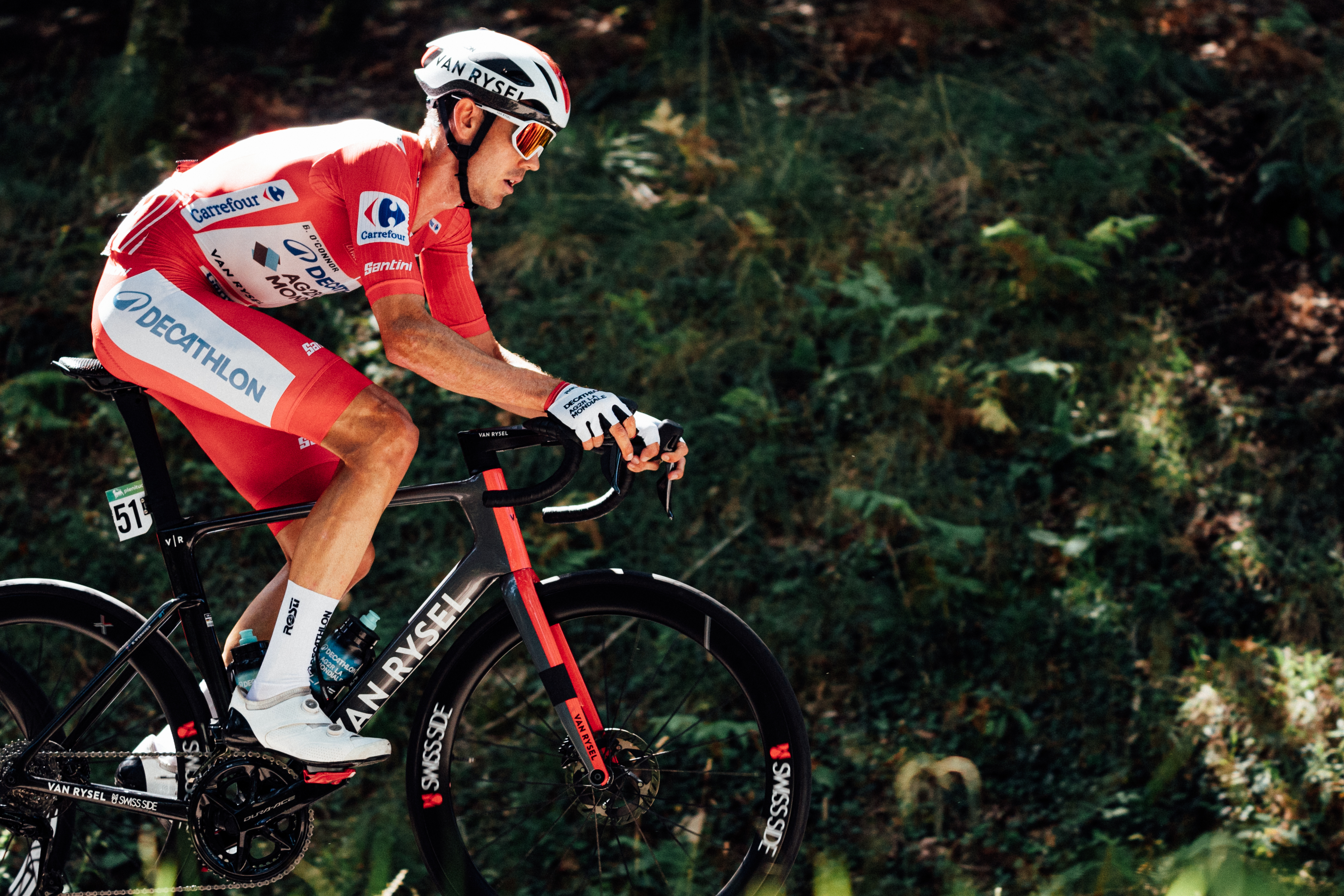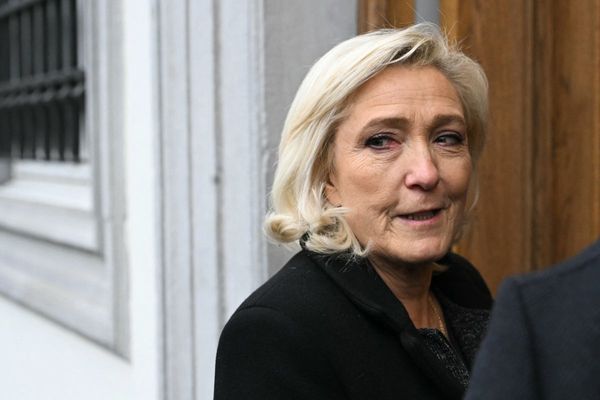
We’re more than halfway through the 2024 Vuelta a España now, but one of the few conclusions that can be drawn so far is - nobody on GC has yet been consistently good enough to stand head and shoulders above the rest.
With two scorching uphill stage wins and a current second place overall, not to mention his past Vuelta a España and Grand Tour history, Primoz Roglič (Red Bull-Bora-Hansgrohe) has done more than enough to remain the key GC reference point. And Ben O’Connor (Decathlon AG2R La Mondiale) certainly has a large but - to judge how rapidly he lost over 30 seconds on a short climb the other day - potentially brittle overall lead. However, as Roglič showed at Sierra Nevada and O’Connor at Cazorla and Padron, performance-wise in the Vuelta neither the Slovenian nor the Australian have shone equally brightly on successive days. Instead, for now, they’re only narrowly ahead as favourites: joint firsts, you could say, amongst equals.
This could all change fast in the coming mountain stages, but even without the dominating figures of Tadej Pogačar (UAE Team Emirates) and Tour runner-up Jonas Vingegaard (Visma-Lease a Bike) in the earlier Grand Tours of this season, nobody seems yet able to get a rock-solid foothold on the upper levels of the Vuelta GC. And at the same time, too, collectively no single team appears to have the overall, across-the-board strength which we saw, for example, with UAE Team Emirates in the Tour de France. Which in turn begs the question - why?
“Obviously there will not be one specific reason for it,” Mathieu Heijboer, Head of Performance at Visma-Lease a Bike, tells Cyclingnews.
“But I do think that one of the reasons is that a lot of riders did the Tour de France, and to my knowledge - except in our team, actually - there have not been a lot of riders specifically preparing the Vuelta as their main goal of the season.
“For example, Enric Mas (Movistar) did the Tour, so did most of the UAE guys as well, (Joao Almeida, Adam Yates, Marc Soler, Pavel Sivakov). In our case, we have Sepp [Kuss, 2023 Vuelta winner] who did prepare for the Vuelta but he was actually scheduled for the Tour.
“So he had also, let’s say, a disturbed preparation because first he had to recover from COVID and then he was able to train, but the whole thing really took a long time. So I think there is one reason” - racing the Tour - “and then on top of that, there’s no dominant team, either, which makes the race hard to control for any team in general.”
The lack of a single team making the running has a snowball effect, Heijboer points out, as it creates opportunities for bigger, more powerful breaks. O’Connor forming part of a long-distance move on stage 6 is one such clear example, and so are three UAE heavyweights - Adam Yates, Jay Vine and Marc Soler - getting in another on stage 9.
Taking Heijboer’s argument a step further, you could even argue that some top teams uncertainty over the strength of the firepower in their squads - because of this generalized lack of specific Vuelta preparation - partly underpins the very uneven collaboration between squads when it comes to chasing down breaks, too. That certainly happened on stage 6 with the half-hearted pursuit of O'Connor. So that uncertainty makes for an even more uncontrolled race, too, and one where it’s harder for a team or rider to make a more definitive impact on GC.
With high numbers of Tour participants now in the Vuelta, the lack of specific preparation for Spain is partly due to a simple calendar shift, too. Last year there were five weeks between one Grand Tour and the next, this year there have only been four. As Adam Yates told Cyclingnews before the Vuelta, that lower period meant all he really had time to do was get home and rest a bit, prior to training for a couple of weeks and then heading to Lisbon. Going to altitude camp to really benefit from it just wasn’t practical.
“If you do the Tour, obviously you can’t do it,” Heijboer says. “Even last year with a week more between the two with Sepp Kuss, we didn’t do altitude training, we just made sure he recovered from the Tour. He was at home because that way you come to race more easily and that allowed him to pick up training pretty quickly.
“So if you do the Tour, there’s not much room for altitude. Many riders didn’t do specific preparation and that’s why the Vuelta goes as it goes.”
Apart from a widespread impaired Vuelta build-up, the impact of the Tour makes itself felt in other ways as well, Heijboer points out. Physically the Tour demands a lengthy recovery, of course, but at the same time the incredibly high degree of mental pressure everybody feels when racing the biggest cycling event in the world then inevitably makes for a period of ‘down-time’ afterwards. And not everybody can return so fast to a racing mindset as the Vuelta demands.
“We have to know that the physiological load of the Tour is very high and there are a lot of very hard stages,” Heijboer explains. “But it’s also very hard racing because every stage is important in the Tour, so there’s a lot of pressure on every rider there to perform and play a part in the team goals, and that means also a much higher psychological load. All the media and the attention before and after the stages, that also takes a toll.”
Heijboer says he talked to Wout van Aert a few days back, and as he says, “Wout was really surprised at how big the difference is between the Vuelta and the Tour in terms of obligations after the stage.” (Van Aert has won three stages to date and currently heads the points classification, as well as leading the race for two, so has had daily multiple post-race protocol duties.)
“He said the Vuelta is a Grand Tour but it’s so laidback that really helps him in terms of recovery. Whereas in the Tour, every small detail is really enlarged, everything is a news item - so when you put it all together physically and psychologically, it makes the Tour a very hard race.”
Knock-on Effects

The knock-on effect of that is worth bearing in mind in the Vuelta, too, of course, along with the very individual reactions of each rider to what they have had to go through in the Tour and how they come around after it. Not everybody is a Primož Roglič, a rider with a seeming cast-iron ability to pick up where he left off in July and head to Spain for three and a half more weeks of all-out action. However, even the Red Bull leader spoke about how it was not easy for him to get back into race mode after such a hard crash in the Tour this year and in 2022, in particular, his first 10 days in the Vuelta that followed were notably uneven. Mentally and physically, then, putting the two together is a major, and tricky, challenge.
“After the Tour, you get a real decompensation factor. So it’s really up to the character and the motivation of riders when it comes to how fast they get back into training and get back in the rhythm to be focussed,” Heijboer explains, "Plus after the Tour, when it comes to each training session racing every stage at a high level, there’s the question of how deep your body will allow you to go.”
Interestingly, rather than the infamous difficulty of the Vuelta stages with their multiple mountain top finishes, this year in particular Heijboer points to the early heat as another factor that’s levelling the playing field and making it harder for a rider to stand out. In week 2, the temperatures have thankfully dropped considerably, but in week 1 as far as Granada, they were soaring to the high thirties and sometimes even the low forties, day after day.
Obviously, the heat of the first week played a role,” Heijboer says. One rider worst affected by it was “[Antonio] Tiberi (Lidl-Trek), who was one of the guys who did prepare specifically for the Vuelta, he didn’t do the Tour.” So even for riders like the Italian, who abandoned with heatstroke “that’s also affecting the riders. They can lose a few minutes [because of the heat] or more and then they are out of the GC as well.”
Regarding the harsh beginning to the Vuelta, compared with other years, as Heijboer says, when it came to climbing the first part of the race was actually not so tough. Rather it was the temperatures that took their toll, and he adds his voice to the growing numbers of those arguing that the heat has now reached a point where it can’t just be ‘battled through’ and ignored.
“The three days in Portugal were pretty easy, and I thought it was more an atypical Vuelta in that sense. But the heat has played a big role again and it surprises me there hasn’t been more debate on the health side for the riders. We saw Arensman getting a heat stroke, also Tiberi, one of the favourites, dropping out because of the heat. In my opinion, this first week was really over the limit.”
Looking Ahead

The hottest weather is thankfully behind the 2024 Vuelta, in any case, even as the harder stages are kicking in more and more. But because of all the different factors affecting top riders’ condition - not to mention the increasing level of fatigue all Grand Tours bring - Heijboer feels that the topsy-turvy, rollercoaster nature of the Vuelta we’ve seen so far will likely endure for some time to come.
“It’s hard to say what will happen, but I do think every day especially when the climbs become longer, we might see one top ten rider drop out, either because of a tactical situation and the uncontrollability of the race or just a bad day. So I cannot make a prediction but I do think the top ten will be very different in one week and even more different in two weeks,” he says.
The yo-yo-ing of names in and out of the overall is bound to continue, too. “For sure riders who are further down on GC will have more of a chance to go into the top ten than riders who are already there. Like Adam Yates did on stage 9” - not just taking the stage win in Granada but gaining nearly four minutes overall - “or David Gaudu (Groupama-FDJ) if he’d been able to maintain the pace.”
For now, the only rider who has shown total consistency, he points out, is Enric Mas (Movistar) - also a Tour de France rider, but whose GC bid never really caught fire in July. In general, the Vuelta is proving to be a wide-open event, with a constantly changing pattern at the head of affairs, and also further down the GC ranking.
“Like I said, because no dominant team can control the race from the start, there will always be big groups on the road and riders in the top 20 who can jump back into the top 10," Heijboer concludes. "So from my point of view, it’s definitely really interesting.”







